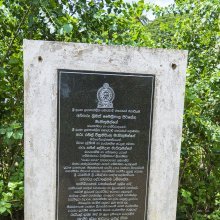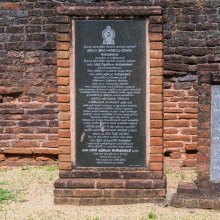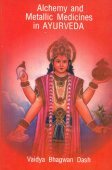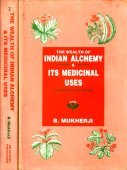Lala, Lālā, Lāla, Laḷa: 26 definitions
Introduction:
Lala means something in Buddhism, Pali, Hinduism, Sanskrit, the history of ancient India, Marathi, Jainism, Prakrit, Hindi, Tamil. If you want to know the exact meaning, history, etymology or English translation of this term then check out the descriptions on this page. Add your comment or reference to a book if you want to contribute to this summary article.
The Sanskrit term Laḷa can be transliterated into English as Lala or Lalia, using the IAST transliteration scheme (?).
Images (photo gallery)
In Hinduism
Purana and Itihasa (epic history)
Source: JatLand: List of Mahabharata people and placesLala (लल) is a name mentioned in the Mahābhārata (cf. II.48.5 II.48.5) and represents one of the many proper names used for people and places. Note: The Mahābhārata (mentioning Lala) is a Sanskrit epic poem consisting of 100,000 ślokas (metrical verses) and is over 2000 years old.

The Purana (पुराण, purāṇas) refers to Sanskrit literature preserving ancient India’s vast cultural history, including historical legends, religious ceremonies, various arts and sciences. The eighteen mahapuranas total over 400,000 shlokas (metrical couplets) and date to at least several centuries BCE.
Vaishnavism (Vaishava dharma)
Source: Pure Bhakti: Bhajana-rahasya - 2nd EditionLālā (लाला) refers to:—A Brajabhāṣā term of affectionate address for a young boy. (cf. Glossary page from Bhajana-Rahasya).

Vaishnava (वैष्णव, vaiṣṇava) or vaishnavism (vaiṣṇavism) represents a tradition of Hinduism worshipping Vishnu as the supreme Lord. Similar to the Shaktism and Shaivism traditions, Vaishnavism also developed as an individual movement, famous for its exposition of the dashavatara (‘ten avatars of Vishnu’).
Ayurveda (science of life)
Source: gurumukhi.ru: Ayurveda glossary of termsLālā (लाला):—Saliva

Āyurveda (आयुर्वेद, ayurveda) is a branch of Indian science dealing with medicine, herbalism, taxology, anatomy, surgery, alchemy and related topics. Traditional practice of Āyurveda in ancient India dates back to at least the first millenium BC. Literature is commonly written in Sanskrit using various poetic metres.
Yoga (school of philosophy)
Source: ORA: Amanaska (king of all yogas): A Critical Edition and Annotated Translation by Jason BirchLālā (लाला) refers to “saliva”, according to the Amaraughaprabodha: a short 13th century treatise on Yoga attributed to Gorakṣanātha which teaches the fourfold system of yoga (Mantra, Laya, Haṭha and Rāja).—Accordingly, “Some drink urine, their own impurity. Some eat their saliva (lālā) as food. Some draw up [their] semen that falls from a woman’s vagina after having penetrated [her]. And some who are skilled in circulating the breath through the channels of the entire body, consume dhātus. They do not have mastery of the body without [the state of] Rājayoga, in which their minds are absent. When the mind has attained equanimity and the breath moves into the central channel, [then] these Amarolī, Vajrolī and Sahajolī [Mudras] arise”.

Yoga is originally considered a branch of Hindu philosophy (astika), but both ancient and modern Yoga combine the physical, mental and spiritual. Yoga teaches various physical techniques also known as āsanas (postures), used for various purposes (eg., meditation, contemplation, relaxation).
In Buddhism
Theravada (major branch of Buddhism)
Source: Pali Kanon: Pali Proper NamesA country in India, the capital of which was Sihapura; it was the birthplace of Vijaya, founder of the Singhalese dynasty (Dpv.ix.5; Mhv.vi.5, 36).
The country is now generally identified with the modern Gujarat, the Larika of Ptolemy.
Theravāda is a major branch of Buddhism having the the Pali canon (tipitaka) as their canonical literature, which includes the vinaya-pitaka (monastic rules), the sutta-pitaka (Buddhist sermons) and the abhidhamma-pitaka (philosophy and psychology).
Mahayana (major branch of Buddhism)
Source: Wisdom Library: Maha Prajnaparamita SastraLālā (लाला) refers to “saliva”, according to Mahāprajñāpāramitāśāstra (chapter 31).—Accordingly, “[...] This body with its nine gates (nanadvāra [=navadvāra?]) is always secreting impurity: the eyes (akṣi) spill out rheum (akṣi-gūthaka) and tears (aśru); the ears (karṇa) produce wax (karṇagūthaka); the nose (nāsā) contains snot (siṃghāṇaka); the mouth (mukha) has saliva (lālā) and vomit (vāntīkṛta); the anus (guda) and the urethra (mūtramārga) constantly empty out excrement (viṣ) and urine (mūtra); and the hair-pores (romakūpa) sweaty impurity. [...]”.
Source: archive.org: Bulletin of the French School of the Far East (volume 5)Lala (लल) [?] [or Lāṭa ?] (in Chinese: Lo-lo) is the name of an ancient kingdom associated with Rohiṇī or Rohiṇīnakṣatra, as mentioned in chapter 18 of the Candragarbha: the 55th section of the Mahāsaṃnipāta-sūtra, a large compilation of Sūtras (texts) in Mahāyāna Buddhism partly available in Sanskrit, Tibetan and Chinese.—Chapter 18 deals with geographical astrology and, in conversation with Brahmarāja and others, Buddha explains how he entrusts the Nakṣatras [e.g., Rohiṇī] with a group of kingdoms [e.g., Lala] for the sake of protection and prosperity.

Mahayana (महायान, mahāyāna) is a major branch of Buddhism focusing on the path of a Bodhisattva (spiritual aspirants/ enlightened beings). Extant literature is vast and primarely composed in the Sanskrit language. There are many sūtras of which some of the earliest are the various Prajñāpāramitā sūtras.
India history and geography
Source: What is India: Inscriptions of the Early Gupta KingsLala (लल).—The Māṇikiālā inscription of the time of Kaniṣka and dated in the year 18 of his reign makes mention of another daṇḍanāyaka called Lala who calls himself a scion of the Guṣaṇa (Kuṣāṇa) race. It is worthy of note that this rank of the daṇḍanāyaka was unknown prior to the time of the Kuṣāṇas.

The history of India traces the identification of countries, villages, towns and other regions of India, as well as mythology, zoology, royal dynasties, rulers, tribes, local festivities and traditions and regional languages. Ancient India enjoyed religious freedom and encourages the path of Dharma, a concept common to Buddhism, Hinduism, and Jainism.
Languages of India and abroad
Pali-English dictionary
Source: Sutta: The Pali Text Society's Pali-English DictionaryLālā, (f.) (cp. laḷati) saliva J. I, 61, 248; VI, 357; Vism. 259; DhA. I, 307 (mukhato lālā galati). (Page 583)
— or —
1) Lāla, (p)pana (nt.) & °ā (f.)=lālappa, together with lāla(p)‹-› pitatta (nt.) in exegesis of parideva at Nd2 416; Vbh. 100, 138; VbhA. 104; DA. I, 121. (Page 583)
2) Lāla, (adj.) (fr. lal, see laḷati) talking without sense, silly, foolish J. VI, 360, 417 (ḷ). Cp. alālā. (Page 583)

Pali is the language of the Tipiṭaka, which is the sacred canon of Theravāda Buddhism and contains much of the Buddha’s speech. Closeley related to Sanskrit, both languages are used interchangeably between religions.
Marathi-English dictionary
Source: DDSA: The Molesworth Marathi and English Dictionarylaḷā (लळा).—m (lala or laḍa S) Fond affection or attachment towards (as towards a child or an animal one has fondled or fed). v kara, bāḷaga, pāḷa, lāva. Pr. lāvaśīla laḷā tara paḍēla gaḷāṃ; Ex. dēva kṛpēcā kōva- ḷā || śaraṇāgatācā pāḷī laḷā ||. 2 Coaxing or endearments on the part of the child or dependent. Ex. mulācā laḷā āī bāpānīṃ puravāvā bhaktācā laḷā- dēva puravitō. Properly or primarily, laḷā is the fondness of the parent or superior party, but, popularly, it is fondness directed whether downwards or upwards. laḷā cālaviṇēṃ or puraviṇēṃ To gratify the fond coaxing and fond pressing of; to fondle, cocker, indulge, pet.
--- OR ---
lāla (लाल).—a ( P) Red. More frequently used as an enhancing affix to tāmbaḍā; as tāmbaḍālāla.
--- OR ---
lāla (लाल).—m ( P) A ruby. 2 A bird, the male of Fringilla Amandava.
--- OR ---
lāḷa (लाळ).—f (lālā S) Saliva or spittle: also spawl or slaver. 2 A disease incidental to cattle, consisting of running at the mouth and rottenness in the feet; the distemper. v yē, jā. lāḷa gaḷaṇēṃ g. of s. & o. To hold intimate friendship or to have flowing affection (together, towards, with). Ex. kāya tyā dōghāñcī lāḷa gaḷatī. lāḷa ghōṇṭaṇēṃ To slaver; or to lick one's chaps; to have one's mouth watering (in expectation of something nice). lāḷēnēṃ caṇē bhijavūna khāṇēṃ (To eat gram moistened only with one's own saliva.) To solace one's self under the omission of honors &c. due or expected, by determinedly holding the assurance that they will yet be rendered.
--- OR ---
lāḷa (लाळ).—f A fine end (as of a thorn); a bristle or hair (as of the awn of corn or grass); a fine splinter in general; esp. as lodging in, or with reference to lodgment in, the flesh. v śira, rāha, kāḍha. Also the very extremity of the dart of a scorpion.
Source: DDSA: The Aryabhusan school dictionary, Marathi-Englishlaḷā (लळा).—m Fond attachment towards.
--- OR ---
lāla (लाल).—a Red. m A ruby.
--- OR ---
lāḷa (लाळ).—f Saliva, spittle; slaver. A disease incidental to cattle. lāḷa gaḷaṇēṃ Have flowing affection (towards), hold intimate friendship with. lāḷa ghōṇṭaṇēṃ Slaver; lick one's chaps; to have one's mouth watering (on expecta- tion of something nice) lāḷēnēṃ caṇē bhijavūna khāṇēṃ (To eat grams moistened only with one's own saliva). To solace one's self under the omission of honours &c. due or expected, by determinedly holding the assurance that they will yet be rendered.
Marathi is an Indo-European language having over 70 million native speakers people in (predominantly) Maharashtra India. Marathi, like many other Indo-Aryan languages, evolved from early forms of Prakrit, which itself is a subset of Sanskrit, one of the most ancient languages of the world.
Sanskrit dictionary
Source: DDSA: The practical Sanskrit-English dictionaryLala (लल).—a.
1) Playful, sportive.
2) Lolling
3) Wishing, desirous.
-lam 1 A shoot, sprout.
2) A garden.
--- OR ---
Lāla (लाल).—
1) Persuasion.
2) A secret matter.
Derivable forms: lālam (लालम्).
--- OR ---
Lālā (लाला).—[lal-ṇic ac ṭāp] Saliva, spittle; कृमिकुलचितं लालाक्लिन्नम् (kṛmikulacitaṃ lālāklinnam) Bhartṛhari 2.9.
Source: Cologne Digital Sanskrit Dictionaries: Shabda-Sagara Sanskrit-English DictionaryLala (लल).—mfn.
(-laḥ-lā-laṃ) 1. Sporting, frolicking. 2. Lolling, wagging. 3. Wishing, desirous. E. laḍ or lal to sport, ac aff.
--- OR ---
Lālā (लाला).—f.
(-lā) Saliva, spittle. E. lal to wish, ṇic-ac and ṭāp affs.
Source: Cologne Digital Sanskrit Dictionaries: Benfey Sanskrit-English DictionaryLālā (लाला).— (akin to lī), f. Saliva, spittle, [Bhartṛhari, (ed. Bohlen.)] 2, 9; [Ṛtusaṃhāra] 1, 5.
Source: Cologne Digital Sanskrit Dictionaries: Cappeller Sanskrit-English DictionaryLāla (लाल).—[masculine] a man’s name (cf. lalla).
--- OR ---
Lālā (लाला).—[feminine] spittle.
Source: Cologne Digital Sanskrit Dictionaries: Aufrecht Catalogus CatalogorumLāla (लाल) as mentioned in Aufrecht’s Catalogus Catalogorum:—astronomer in Kānyakubja, father of Devīdāsa, Kṣemakarṇa, Nārāyaṇa, Caturbhuja Miśra and Dāmodara, grandfather of Harirāma and Balabhadra (Hāyanaratna 1655). W. p. 264.
Source: Cologne Digital Sanskrit Dictionaries: Monier-Williams Sanskrit-English Dictionary1) Lala (लल):—[from lal] mfn. sporting, playful, [Horace H. Wilson]
2) [v.s. ...] lolling, wagging, [ib.]
3) [v.s. ...] wishing, desirous, [ib.]
4) [v.s. ...] m. a [particular] fragrant substance, [Demetrius Galanos’s Lexiko: sanskritikes, anglikes, hellenikes]
5) [v.s. ...] n. a shoot, sprout, [cf. Lexicographers, esp. such as amarasiṃha, halāyudha, hemacandra, etc.]
6) [v.s. ...] a garden, [cf. Lexicographers, esp. such as amarasiṃha, halāyudha, hemacandra, etc.]
7) Lāla (लाल):—[from lal] a m. the son of a Maitreya and a Brāhmaṇī, [cf. Lexicographers, esp. such as amarasiṃha, halāyudha, hemacandra, etc.]
8) [v.s. ...] Name of an astronomer in Kānyakubja, [Catalogue(s)]
9) [v.s. ...] (with paṇḍita and vihārin) of two other authors, [ib.]
10) Lālā (लाला):—[from lāla > lal] a f. See below
11) Lāla (लाल):—[from lal] n. (only [cf. Lexicographers, esp. such as amarasiṃha, halāyudha, hemacandra, etc.]) persuasion
12) [v.s. ...] a secret matter
13) [v.s. ...] the wife of another.
14) Lālā (लाला):—[from lal] b f. saliva, spittle, slobber, [Kāvya literature; Varāha-mihira; Suśruta] etc.
15) [v.s. ...] a species of myrobalan, [cf. Lexicographers, esp. such as amarasiṃha, halāyudha, hemacandra, etc.]
16) Lāla (लाल):—b lālaka, lālana etc. See p. 898, col. 1.
Source: Cologne Digital Sanskrit Dictionaries: Yates Sanskrit-English Dictionary1) Lala (लल):—[(laḥ-lā-laṃ) a.] Sporting; wishing.
2) Lālā (लाला):—(lā) 1. f. Saliva.
Source: DDSA: Paia-sadda-mahannavo; a comprehensive Prakrit Hindi dictionary (S)Lāla (लाल) in the Sanskrit language is related to the Prakrit words: Lāla, Lālā.
[Sanskrit to German]
Sanskrit, also spelled संस्कृतम् (saṃskṛtam), is an ancient language of India commonly seen as the grandmother of the Indo-European language family (even English!). Closely allied with Prakrit and Pali, Sanskrit is more exhaustive in both grammar and terms and has the most extensive collection of literature in the world, greatly surpassing its sister-languages Greek and Latin.
Hindi dictionary
Source: DDSA: A practical Hindi-English dictionary1) Lalā (लला):—(nm) a word of address or a vocative word for a child/boy.
2) Lāla (लाल) [Also spelled lal]:—(a) red, ruddy; angry, infuriated; communist (as —[cīna]); (nm) beloved/dear child/boy/son; beloved person; a kind of small bird; ruby; —[aṃgārā/bhabhūkā] extremely red, red hot; red hot due to anger, terribly infuriated; —[caṃdana] red sandalwood; —[pagaḍī] the police (man); —[parī] wine, liquor; —[pānī] wine, liquor; ~[phītā] red tape; •[śāhī] red-tapism; —[bujhakkaḍa] village wisecare, an ignorant fool who thinks very highly of himself and feels competent to answer any question; •[būjhihai aura na būjhai koya] the ass waggeth his ears; —[mirca] chilly; —[śakkara] unrefined/crude sugar; —[sāgara] red sea; —[senā] communist army; —[āṃkheṃ dikhānā/nikālanā] to look angrily, to frown; -[pīlā honā] to be black in the face, to be purple with passion; to fret and fume, to be red hot with rage.
3) Lālā (लाला):—(nm) a word of respect prefixed to the names of certain Hindu castes like [baniyā] and [kāyastha] etc. (as —[lājapatarāya]); a term of address used for both elders and youngers; a kind of flower or its plant.
4) Lala in Hindi refers in English to:—(nf) sport, play; amorous sport; fun and frolic; stage representation [of the deeds of divine incarnations, e.g, [ramalila, rasa-lila]; -kalaha] love strife; ~[priya] frolicsome; ~[purusha] an epithet of Lord Krishna who revelled in his divine sport; ~[maya] sportive; playful; ~[sthala] site of amorous sport/play..—lala (लीला) is alternatively transliterated as Līlā.
...
Prakrit-English dictionary
Source: DDSA: Paia-sadda-mahannavo; a comprehensive Prakrit Hindi dictionary1) Lala (लल) in the Prakrit language is related to the Sanskrit words: Lla, Laṅ.
2) Lāla (लाल) also relates to the Sanskrit word: Lāla.
3) Lālā (लाला) also relates to the Sanskrit word: Lālā.
Prakrit is an ancient language closely associated with both Pali and Sanskrit. Jain literature is often composed in this language or sub-dialects, such as the Agamas and their commentaries which are written in Ardhamagadhi and Maharashtri Prakrit. The earliest extant texts can be dated to as early as the 4th century BCE although core portions might be older.
Kannada-English dictionary
Source: Alar: Kannada-English corpusLāla (ಲಾಲ):—
1) [noun] the tree Shorea robusta ( = S. talura, - Vatica robusta) of Dipterocarpaceae family; the Sal tree.
2) [noun] the resinous exudation of this tree.
--- OR ---
Lāḷa (ಲಾಳ):—
1) [noun] a length of hollow pipe of metal, glass, rubber, etc. for conveying fluids, gas, etc.
2) [noun] the reed of the grass Saccharum fuscum of Poaceae family, used for writing with; a reed-pen; ಲಾಳದ ಕಡ್ಡಿ [lalada kaddi] lāḷada kaḍḍi = ಲಾಳ [lala]1 - 2.
--- OR ---
Lāḷa (ಲಾಳ):—
1) [noun] old name of an old country corresponding to the present Gujarat state in the western part of India.
2) [noun] a man belonging to this country.
3) [noun] the language of this country; Gujarāti.
4) [noun] worn out clothes, garments or shabby ornaments.
5) [noun] a particular lock or hold in wrestling.
--- OR ---
Lāḷa (ಲಾಳ):—
1) [noun] a metal plate nailed to the hooves of oxen, horses, etc. for protection; a shoe.
2) [noun] a payment made or to be made by the players of the game of chance to the person who runs such a club.
--- OR ---
Lāḻa (ಲಾೞ):—[noun] = ಲಾಳ [lala]2.
Kannada is a Dravidian language (as opposed to the Indo-European language family) mainly spoken in the southwestern region of India.
Tamil dictionary
Source: DDSA: University of Madras: Tamil LexiconLālā (லாலா) noun < Hindustain lālā.
1. A caste of Hindu merchants who migrated into the Tamil country from Northern India; வடநாட்டி லிருந்து தமிழ்நாட்டிற் குடியேறிய இந்துவியாபாரி. [vadanatti lirunthu thamizhnattir kudiyeriya inthuviyapari.]
2. A term of respect; ஒரு சிறப்புப்பெயர். [oru sirappuppeyar.]
3. A term of endearment; ஒரு செல்வப்பெயர். நந்தலாலா. [oru selvappeyar. nanthalala.]
Tamil is an ancient language of India from the Dravidian family spoken by roughly 250 million people mainly in southern India and Sri Lanka.
Nepali dictionary
Source: unoes: Nepali-English Dictionary1) Lala (लल):—interj. 1. the word uttered in acceptance; 'Yes, yes'; 'Okay, okay';
2) Lāla (लाल):—n. 1. child; infant; 2. son; 3. crab's eye; 4. a measure of gold; adj. red;
3) Lālā (लाला):—n. 1. infant; baby; 2. dear son;
Nepali is the primary language of the Nepalese people counting almost 20 million native speakers. The country of Nepal is situated in the Himalaya mountain range to the north of India.
See also (Relevant definitions)
Partial matches: A, Hi, Alia, Ala, Na.
Starts with (+21): Lala bahadur, Lala Bhadaka, Lala bhatta, Lala pandita, Lala thakkura, Lala viharin, Lalabagu, Lalabamdi, Lalabhadaka, Lalabhaica Curama, Lalabhaksha, Lalacandra, Lalachardi, Laladambu, Laladimba, Lalagudige, Lalagumdige, Lalai, Lalajihva, Lalakattu.
Query error!
Full-text (+153): Lalasrava, Ashvalala, Ullala, Lalavisha, Lalameha, Lalabhaksha, Nandalala, Lalacandra, Lalapana, Lalasravin, Lalasimha, Lallujilala, Laladambu, Lalajihva, Lalamani, Vrajalala, Lalavat, Lalamishra, Shivalala, Lalamati.
Relevant text
Search found 81 books and stories containing Lala, A-ala, Ā-ala, Aḷa-a-hi, Ala-na, Ala-ṇa, Ala-na, Ālā-ṇa, Ala-na, Ala-ṇa, Alia-a-hi, Laalaa, Lālā, Lāla, Laḷā, Lalā, Lāḷa, Lāḻa, Laḷa; (plurals include: Lalas, alas, his, nas, ṇas, Laalaas, Lālās, Lālas, Laḷās, Lalās, Lāḷas, Lāḻas, Laḷas). You can also click to the full overview containing English textual excerpts. Below are direct links for the most relevant articles:
Dipavamsa (study) (by Sibani Barman)
Vakyapadiya of Bhartrihari (by K. A. Subramania Iyer)
Verse 3.14.220 < [Book 3 - Pada-kāṇḍa (14): Vṛtti-samuddeśa (On Ccomplex Formation)]
Verse 3.14.219 < [Book 3 - Pada-kāṇḍa (14): Vṛtti-samuddeśa (On Ccomplex Formation)]
Garga Samhita (English) (by Danavir Goswami)
Verse 4.19.55 < [Chapter 19 - A Thousand Names of Srī Yamunā]
Bhakti-rasamrta-sindhu (by Śrīla Rūpa Gosvāmī)
Verse 2.2.16 < [Part 2 - Ecstatic Expressions (anubhāva)]
Verse 2.2.2 < [Part 2 - Ecstatic Expressions (anubhāva)]
Verse 2.4.88 < [Part 4 - Transient Ecstatic Disturbances (vyābhicāri-bhāva)]
Bhajana-Rahasya (by Srila Bhaktivinoda Thakura Mahasaya)
Text 44 < [Chapter 2 - Dvitīya-yāma-sādhana (Prātaḥ-kālīya-bhajana)]
Text 22 < [Chapter 5 - Pañcama-yāma-sādhana (Aparāhna-kālīya-bhajana–kṛṣṇa-āsakti)]
Chaitanya Bhagavata (by Bhumipati Dāsa)
Verse 3.5.169 < [Chapter 5 - The Pastimes of Nityānanda]
Verse 3.5.160 < [Chapter 5 - The Pastimes of Nityānanda]
Verse 3.5.173 < [Chapter 5 - The Pastimes of Nityānanda]
Related products




